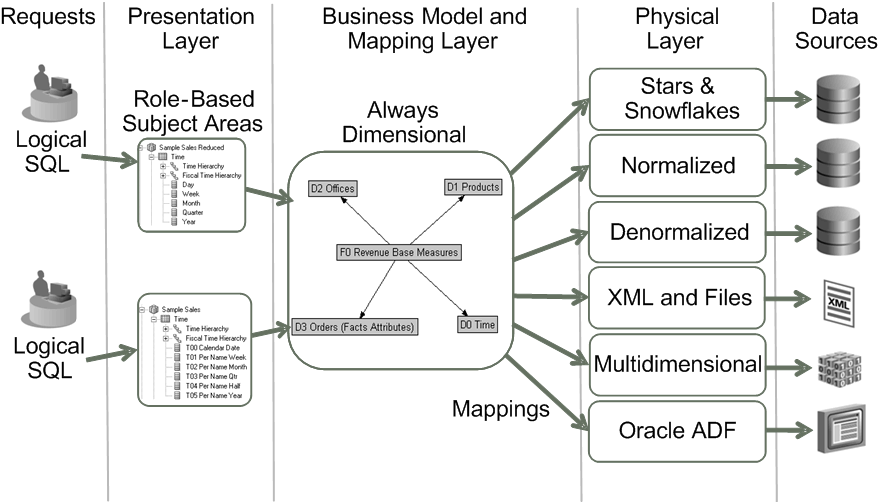About Layers in the Oracle BI Repository
Layers in the Oracle BI Repository define the objects and their relationships.
An Oracle BI Repository has the following layers:
-
Physical layer. This layer defines the objects and relationships that the Oracle BI Server needs to write native queries against each physical data source. You create this layer by importing tables, cubes, and flat files from your data sources.
Separating the logical behavior of the application from the physical model provides the ability to federate multiple physical sources to the same logical object, enabling aggregate navigation and partitioning, as well as, dimension conformance and isolation from changes in the physical sources. This separation also enables the creation of portable Oracle BI Applications.
-
Business Model and Mapping layer. This layer defines the business or logical model of the data and specifies the mapping between the business model and the physical schemas. This layer determines the analytic behavior seen by users, and defines the superset of objects and relationships available to users. Business Model and Mapping layer hides the complexity of the source data models.
Each column in the business model maps to one or more columns in the Physical layer. At run time, the Oracle BI Server evaluates Logical SQL requests against the business model, and then uses the mappings to determine the best set of physical tables, files, and cubes for generating the necessary physical queries. The mappings often contain calculations and transformations, and might combine multiple physical tables.
-
Presentation layer. This layer provides a way to present customized, secure, role based views of a business model to users. It adds a level of abstraction over the Business Model and Mapping layer and provides the view of the data seen by users building requests in Presentation Services and other clients.
You can create multiple subject areas in the Presentation layer that map to a single business model, effectively breaking up the business model into manageable pieces.
Before you build any repository layers in the Administration Tool, it is important to create a high-level design of the Business Model and Mapping layer based on the analytic requirements of your users. After you have a conceptual design to work toward, you can then build your metadata objects.
You should create the Physical layer objects first, next create the Business Model and Mapping layer objects, and then create Presentation layer objects. You can work on each layer at any stage. After you complete all three layers, you can set up security when you are ready to begin testing the repository.
The figure shows how a Logical SQL query traverses the layers of an Oracle BI Repository.
A single Oracle BI Repository can contain two or more independent semantic models, rather than a single, integrated, enterprise-wide model. A semantic model consists of one business model, its related objects in the Presentation and Physical layers, and additional related objects like variables, initialization blocks, and application roles. A semantic model is also known as a Common Enterprise Information Model (CEIM).
See About Multiuser Development Styles for a visual representation of multiple semantic models.
